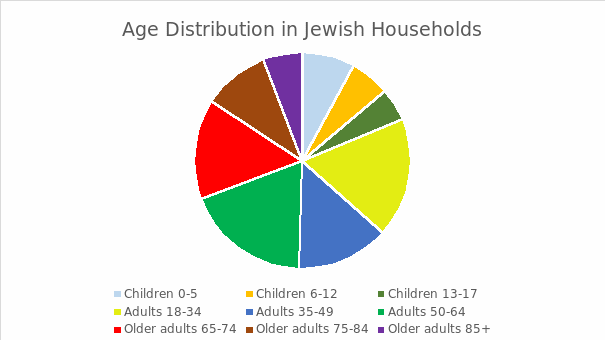Introduction
The United States have a diverse population, and the share of Jews in it is rather big. As of 2015, there were about 16 million Jews around the world. The United States have the second world’s largest Jewish population of 5.7 million. Their communities are spread throughout the country. The Miami Jewish community is the 11th biggest in the USA with 123.200 people (Labgold, 2014).
Jewish in Miami: Demographics
For years the Jewish population was decreasing. Only in 2014, a 9% growth was observed compared to 2004. Some reasons caused this increase. First of all, some Jewish household grew 3% during the last decade. Secondly, the new people came and joined the Jewish community (Labgold, 2014). The majority of the Miami Jewish community are adults (51%). Children and older adults are 19% and 31% correspondently. The chart below represents a more detailed information.

The Jewish community is traditional. 61% of adults are married, 36% are single, widowed or divorced. Only 3% are living with a partner. As for the geographic distribution, there are three major regions in Miami where Jews line. They are North Dade, South Dade, and The Beaches. The North Dade population is the most numerous of the three. It amounts to 68,600 people with the average age of 54. The population of the South Dade decreased within the last decades and was 40,300 as of 2014. The average age was 51, but the proportion of children was shrinking. The Beaches are the youngest Jewish population of Miami. Among the 20,900 people, the average age was reported to be 36. Besides, the population of children was 25% compared to the average 19% of the whole community (Labgold, 2014).
Jewish in Miami: Statistics
There are no direct statistics data on Jewish birth rates in the US available. The situation with mortality rates is similar. According to Norwood (2008), the mortality levels of Jewish American population are little documented. It is not proved that Jewish mortality rates are different from that of the other population. In the recent decades, a decrease of mortality is observed due to the health improvement. It caused the growth of some Jewish communities in the United States. The American Jewish population observed the same tendencies as the general population. These tendencies are the increased life expectancy, higher mortality levels of men compared to women, and cancer and heart disease as the major causes of death. Besides, as Dashefsky and Sheskin mention in “American Jewish Year Book 2015″, in transitional communities, fertility is controlled, and mortality decreases following economic development and health improvement” (2015, p.305).
Evidence-Based Practice in the Local Clinics
Speaking of local clinics, I got interested in the experience of an innovative healthcare provider Miami Jewish Health Systems. They state their aim as ‘to provide compassionate healthcare through a full range of quality services, guided by research and education, honoring traditional Jewish values of dignity and respect” (“About us,” n.d., para.3). Their activity is a good example of evidence-based practices. The organization provides the innovative researches, for example on Alzheimer’s and Dementia. They manage to bring theoretical investigations into practice. It is due to about a dozen programs that annually serve over 12000 patients (“About us,” n.d.). The Miami Jewish Health Systems suggest the residential living, a nursing home, a hospital, rehabilitation programs, community programs, and some other opportunities.
Questionnaire
I had an opportunity to talk to a staff member of Miami Jewish Health Systems. Thus, I have prepared a questionnaire to learn about the peculiarities of health care within a national minority community. Here are the points I wanted to assess.
- What is your position at the health care provider?
- How long have you been working here?
- What is the main goal of this organization?
- Does your clinic support evidence-based practice?
- What are the peculiarities of work with patients from the Jewish community?
- Are there any characteristic traits about the health care in a religious community?
The person I talked to is a nurse at the hospital of Miami Jewish Health Systems. She has been working there for six years and looks satisfied to be a member of the team. She characterizes the goal of the organization being innovative, promoting healthier and longer lives, and providing the health care of the highest quality. She agrees that evidence-based practice is applied throughout the activities, both medical and organizational. The Miami Jewish Health Systems give certain attention to the research. Its aim is to study the problem, formulate the solutions, and bring them into practice to improve the health care they provide.
My interviewee also mentioned the peculiar features of work with the Jewish community. These peculiarities include much attention to family, so the Systems suggest some family resources. Another feature is that the community is mainly religious, so this should be considered, for example, with organizing meals, because the Kosher food is needed.
Conclusions
On the whole, the Jewish community is an active and constantly changing component of the American society. Its members have specific traits which should be considered. It is especially true about the health-care system. It is obvious that the good knowledge of the subject’s peculiarities will positively influence the health care delivery.
References
About us. (n.d.). Miami Jewish Health Systems. Web.
Dashefsky, A., & Sheskin, I.M. (Eds.). (2015) American Jewish year book 2015: The annual record of the North American Jewish communities. New York, NY: Springer International Publishing.
Labgold, M. (2014). Summary report of the 2014 Greater Miami Jewish Federation Population study: A portrait of the Miami Jewish Community. Web.
Norwood, S.H., & Pollak, E.G. (Eds.). (2008). Encyclopedia of American Jewish history. (Vol.1). Santa Barbara, CA: ABC-CLIO, 2008.